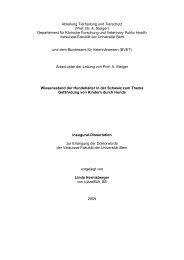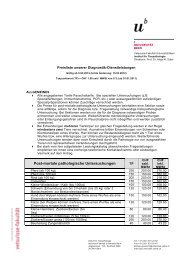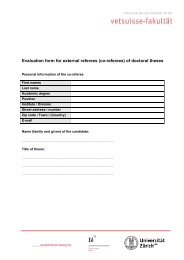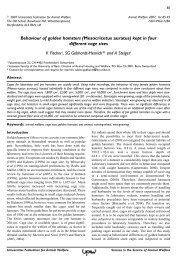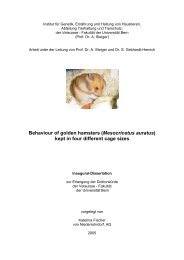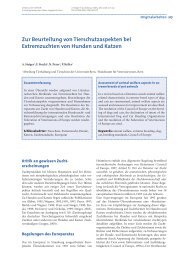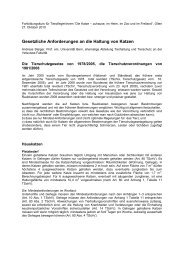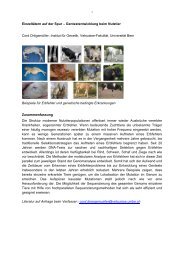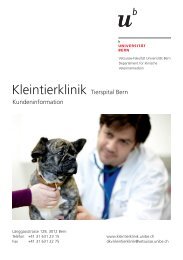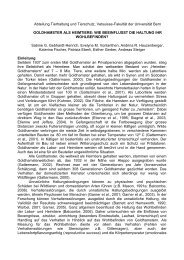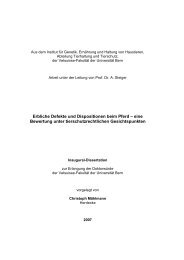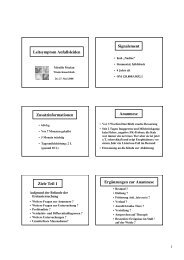Lifespan and Causes of Death in the Irish Wolfhound - Vetsuisse ...
Lifespan and Causes of Death in the Irish Wolfhound - Vetsuisse ...
Lifespan and Causes of Death in the Irish Wolfhound - Vetsuisse ...
You also want an ePaper? Increase the reach of your titles
YUMPU automatically turns print PDFs into web optimized ePapers that Google loves.
7.3.3 Hereditary Diseases<br />
Hereditary diseases have been reported to occur <strong>in</strong> almost all dog breeds <strong>and</strong> also <strong>in</strong><br />
mongrels, <strong>and</strong> <strong>the</strong>ir frequency <strong>and</strong> distribution varies depend<strong>in</strong>g on <strong>the</strong> breeds <strong>and</strong><br />
families considered (Peyer 1997; Ackerman 1999; Ruv<strong>in</strong>sky <strong>and</strong> Sampson 2001).<br />
More <strong>and</strong> more such diseases cont<strong>in</strong>ue to be identified, <strong>and</strong> it is entirely possible that<br />
this will also affect <strong>Irish</strong> <strong>Wolfhound</strong>s <strong>in</strong> <strong>the</strong> future. Given <strong>the</strong>se facts, it is unlikely that<br />
<strong>the</strong> domestic dog population will ever be entirely free from hereditary diseases;<br />
however, few would agree that <strong>the</strong> mere occurrence <strong>of</strong> hereditary diseases <strong>in</strong> a breed<br />
<strong>of</strong> dog renders breed<strong>in</strong>g <strong>the</strong> said breed unethical <strong>in</strong> itself. A certa<strong>in</strong> percentage <strong>of</strong> <strong>the</strong><br />
hereditary disease cases that occur <strong>in</strong> breed<strong>in</strong>g can <strong>the</strong>refore be considered to be<br />
unfortunate, but <strong>in</strong>evitable.<br />
Never<strong>the</strong>less, much <strong>of</strong> what has been said <strong>in</strong> <strong>the</strong> previous chapters is equally<br />
applicable to <strong>the</strong> case <strong>of</strong> hereditary diseases <strong>in</strong>s<strong>of</strong>ar as <strong>the</strong>y can be taken as<br />
examples where human <strong>and</strong> animal <strong>in</strong>terests are oppos<strong>in</strong>g. In addition to <strong>the</strong> problem<br />
<strong>of</strong> a shortened lifespan, we are also confronted with suffer<strong>in</strong>g due to both <strong>the</strong><br />
diseases <strong>in</strong> <strong>the</strong>mselves <strong>and</strong>, <strong>in</strong> some cases <strong>and</strong> transiently, to <strong>the</strong>ir veter<strong>in</strong>ary<br />
treatment.<br />
An ethical consideration that is more specific to <strong>the</strong> problem <strong>of</strong> hereditary diseases<br />
would be <strong>the</strong> fact that <strong>the</strong> <strong>in</strong>fluence <strong>of</strong> personal breed<strong>in</strong>g choices on <strong>the</strong>ir rate <strong>of</strong><br />
occurrence is usually def<strong>in</strong>ed more clearly than it is <strong>the</strong> case with lifespan. In this<br />
context, it is possible for a stud dog to be a documented carrier <strong>of</strong> a hereditary<br />
disease, but to produce show-w<strong>in</strong>n<strong>in</strong>g <strong>of</strong>fspr<strong>in</strong>g at <strong>the</strong> same time. However, this is<br />
essentially ano<strong>the</strong>r situation <strong>in</strong> which <strong>the</strong> human <strong>in</strong>terest to satisfy one's own vanity<br />
must be ranked lower than <strong>the</strong> dogs' primary <strong>in</strong>terest not to suffer from a particular<br />
hereditary disease, with all <strong>the</strong> result<strong>in</strong>g ethical implications discussed <strong>in</strong> <strong>the</strong> previous<br />
chapter.<br />
The question <strong>of</strong> hereditary diseases should also be addressed with regard to <strong>the</strong><br />
circumstances that lead to <strong>the</strong>ir occurrence. Hereditary diseases, be<strong>in</strong>g genetic <strong>and</strong><br />
<strong>the</strong>refore essentially stochastic <strong>in</strong> nature, can occasionally occur despite optimal<br />
selection aga<strong>in</strong>st <strong>the</strong>m hav<strong>in</strong>g taken place. The ethical issues beg<strong>in</strong> once <strong>the</strong> dogs'<br />
welfare <strong>in</strong>terests are – deliberately or negligently – replaced by <strong>the</strong> human <strong>in</strong>terest to<br />
satisfy one's emotional <strong>and</strong>/or monetary <strong>in</strong>terests <strong>in</strong> selection. The <strong>in</strong>herent absurdity<br />
<strong>of</strong> this concept may best be illustrated by ask<strong>in</strong>g <strong>the</strong> question <strong>of</strong> how many cases <strong>of</strong><br />
hereditary disease are worth a show champion. A special <strong>and</strong> exemplary case <strong>of</strong> this<br />
is discussed <strong>in</strong> <strong>the</strong> follow<strong>in</strong>g chapter.<br />
7.3.4 Portosystemic Shunt: Study <strong>of</strong> A Special Case<br />
As mentioned <strong>in</strong> chapter 3.2.3, <strong>the</strong> problem <strong>of</strong> PSS represents a peculiar ethical<br />
dilemma that to <strong>the</strong> author's knowledge has not been reported <strong>in</strong> o<strong>the</strong>r hereditary<br />
diseases to-date, even though it has been published beforeh<strong>and</strong> that <strong>Irish</strong> <strong>Wolfhound</strong><br />
breeders were not realis<strong>in</strong>g <strong>the</strong> full potential <strong>of</strong> selection aga<strong>in</strong>st <strong>the</strong> condition<br />
(Ubb<strong>in</strong>k, van de Broeck et al. 1998).<br />
As shown <strong>in</strong> chapter 3.2.1.3, PSS can be diagnosed at an early age through rout<strong>in</strong>e<br />
blood test<strong>in</strong>g (Kerr <strong>and</strong> van Doorn 1999), giv<strong>in</strong>g breeders <strong>the</strong> possibility <strong>of</strong> test<strong>in</strong>g<br />
<strong>the</strong>ir litters before sale, but has a high lethality rate even when properly treated<br />
108



